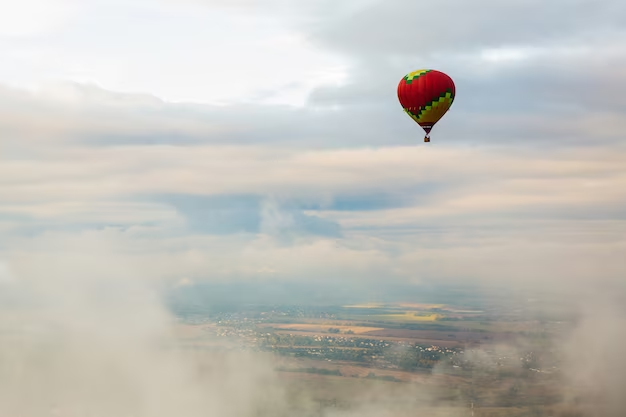Balloon Statistics: Unveiling Accidents & Deaths

Balloons have always been a symbol of joy and celebration, but amidst the vibrant colors and cheerful atmosphere, there lies a hidden reality that often goes unnoticed—the world of balloon statistics. From breathtaking balloon flights to the harsh reality of accidents, join us on this eye-opening journey to understand the crucial figures that shape the ballooning industry.
Understanding the Ballooning Landscape
Before we delve into the specifics of balloon accidents and fatalities, it is essential to grasp the basics of the ballooning landscape. Balloon flights have captivated humans for centuries, offering a unique and serene perspective of the world from above. The breathtaking experience of floating through the air with only a basket beneath your feet is a dream come true for many adventurous souls.
A Brief History of Ballooning
To comprehend the present-day balloon statistics, let’s take a brief journey into the history of ballooning. The first manned hot-air balloon flight took place on November 21, 1783, in Paris, France. Piloted by Jean-François Pilâtre de Rozier and François Laurent d’Arlandes, the balloon traveled over five miles and reached an altitude of approximately 500 feet.
The Thrill of Balloon Flights
Even today, the thrill of balloon flights remains unparalleled. Tourists and adventurers flock to various locations worldwide to experience the enchanting sensation of soaring high above the ground, gently carried by the winds. The allure of witnessing picturesque landscapes from a bird’s-eye view is a major draw for enthusiasts of all ages.
Unveiling Balloon Accident Statistics
While the majority of balloon flights go smoothly, accidents do occur, and it’s vital to be aware of their frequency and impact. Let’s explore the balloon accident statistics to gain a comprehensive understanding of the risks involved.
Total Number of Accidents
Over the past decade, balloon accidents have been reported across the globe. However, it is crucial to note that these accidents are relatively rare compared to other modes of transportation. The total number of accidents varies from year to year, but authorities and ballooning associations have been working diligently to enhance safety measures.
Accidents and Deaths per Year
Despite safety measures, there have been instances where balloon flights turned tragic, resulting in fatalities. The annual occurrence of accidents leading to deaths remains a concerning aspect of ballooning. Analyzing these incidents provides valuable insights into the areas that require further attention to ensure safer flights.

The Factors Behind Balloon Accidents
To truly understand balloon statistics, we must explore the factors that contribute to accidents. Identifying these factors can pave the way for more effective safety protocols.
Weather Conditions and Ballooning
Weather plays a pivotal role in ballooning, and unpredictable weather patterns can lead to accidents. Strong winds, thunderstorms, and sudden changes in atmospheric conditions can pose challenges to even the most experienced balloon pilots.
Human Error and Safety Measures
Like any other form of transportation, human error can be a contributing factor in balloon accidents. Whether it’s a lapse in judgment or a failure to adhere to safety measures, the human element is critical in ensuring accident-free flights.
Comparing Balloon Accidents to Other Modes of Transportation
To put balloon statistics into perspective, let’s compare them to accidents in other modes of transportation.
| Transportation Mode | Accident Frequency (per year) | Fatalities (per year) |
|---|---|---|
| Balloon Flights | Low | Varies |
| Air Travel | Moderate | Moderate |
| Road Transportation | High | High |
| Maritime Travel | Low | Varies |
Tips for Safe Balloon Flights
Before you embark on a thrilling balloon flight, it’s essential to be aware of safety tips that can enhance your overall experience and ensure a safe journey.
Listen to Your Pilot
Your balloon pilot is an experienced professional who knows the ins and outs of ballooning. Pay attention to their instructions and follow their guidance throughout the flight.
Dress Comfortably and Appropriately
Dress in comfortable, weather-appropriate clothing for your balloon adventure. Layering is advisable, as temperatures can vary at different altitudes.
Keep Your Camera Ready
Capture the breathtaking scenery during your balloon flight. Have your camera or smartphone ready to preserve the magical moments.
Stay Seated During Landing
When the balloon prepares to land, remain seated and follow your pilot’s instructions. This helps ensure a smooth and safe landing for everyone.
Participate in the Balloon Inflation
If your pilot allows, take part in the exciting balloon inflation process. It’s an incredible experience to watch the balloon come to life.
Respect Weight Limits
Balloons have weight limits for safety reasons. Always adhere to the weight restrictions set by the operator.
Enjoy the Serenity
Embrace the tranquility and beauty of the moment. Enjoy the quietude and the sense of floating in the sky.
A Comparative Analysis of Popular Balloon Flight Destinations
Let’s compare some of the world’s most popular balloon flight destinations based on their scenic beauty, safety records, and overall experience.
| Destination | Scenic Beauty | Safety Record | Overall Experience |
|---|---|---|---|
| Cappadocia, Turkey | 9/10 | 8/10 | 9/10 |
| Albuquerque, USA | 8/10 | 9/10 | 8/10 |
| Bagan, Myanmar | 10/10 | 7/10 | 9/10 |
| Serengeti, Africa | 9/10 | 8/10 | 9/10 |
| Loire Valley, Fr | 9/10 | 9/10 | 8/10 |
Safety Measures and Regulations in the Ballooning Industry
The ballooning industry takes safety seriously, and several measures and regulations are in place to ensure smooth and secure operations.
Weather Clearance and Flight Cancellations
Before each flight, pilots carefully assess weather conditions and obtain clearance from relevant authorities. In cases of adverse weather, flights may be postponed or canceled for passenger safety.
Maintenance and Inspection Logs
Operators maintain meticulous records of balloon maintenance and inspections. These logs help track the balloon’s condition and identify any issues that need attention.
Licensing and Certification
All pilots and operators must obtain proper licensing and certification to conduct commercial balloon flights. Regular assessments and renewals ensure continued adherence to safety standards.
Passenger Briefings
Prior to takeoff, pilots provide passengers with detailed safety briefings. This includes information about emergency procedures and what to expect during the flight.

The Most Spectacular Hot-Air Balloon Festivals
- Albuquerque International Balloon Fiesta, USA Held annually in Albuquerque, New Mexico, this festival features over 500 colorful balloons and attracts thousands of visitors from around the world;
- Cappadocia Hot Air Balloon Festival, Turkey The unique landscape of Cappadocia provides a stunning backdrop for this festival, creating an otherworldly experience for attendees;
- Festival International de Montgolfières, Canada Located in Saint-Jean-sur-Richelieu, Quebec, this festival showcases hot-air balloons of various shapes and sizes;
- Tanzania Serengeti Balloon Safari Experience the wildlife of Serengeti National Park from a hot-air balloon, combining adventure with breathtaking views;
- European Balloon Festival, Spain Held in Igualada, Catalonia, this festival celebrates the beauty of hot-air balloons with impressive displays and competitions.
Conclusion
Balloon statistics shed light on the risks involved in this exhilarating mode of transportation. While accidents are rare, they serve as a reminder that safety measures and training must remain a priority in the ballooning industry. Understanding the factors contributing to accidents and comparing balloon statistics with other modes of transportation help us contextualize the overall safety landscape.